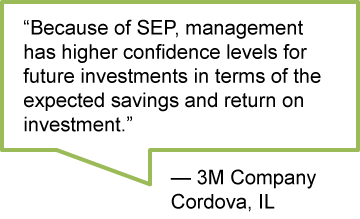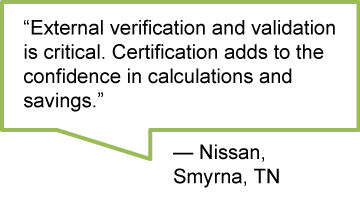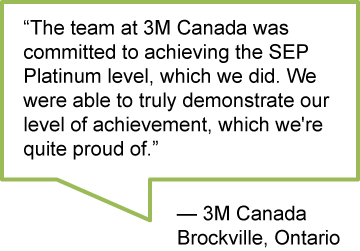 Learn about the certification process for ISO 50001 global energy management systems standard. In addition, learn about the added requirements for Superior Energy Performance® (SEP™) certification. The detailed steps and free online resources outlined below can help your facility reduce energy costs, whether your facility is ready for certification or just beginning to explore energy management.
Learn about the certification process for ISO 50001 global energy management systems standard. In addition, learn about the added requirements for Superior Energy Performance® (SEP™) certification. The detailed steps and free online resources outlined below can help your facility reduce energy costs, whether your facility is ready for certification or just beginning to explore energy management.
DOE is the administrator of the SEP certification program. For questions, contact superiorenergyperformance@ee.doe.gov.
Enroll – View the SEP and ISO 50001 introductory materials
Prepare – Install an energy management system, Review how to qualify for SEP certification, Access the SEP standards and protocols
Apply – Find a verification body, Auditing fees for SEP certification
Verify – Undergo an audit, Recognize achievement, Recertify
Enroll
Enroll to gain access to resources for streamlining the SEP implementation process, such as program updates, tips, and phone support.
No fees or commitment are required. Simply provide some basic facility and contact information to stay connected to the latest information on ISO 50001 and SEP. Download the enrollment form and sign up today.
Visit about SEP to find SEP introductory materials to download and share with management and team members. Learn more about ISO 50001.
Prepare
Preparation involves establishing an EnMS in your facility that meets the ISO 50001 standard. To implement a data-driven EnMS that will deliver the greatest savings, become familiar with EnMS resources, learn how to qualify for SEP, and access SEP standards and protocols.
Review How to Qualify for Certification
To become certified to SEP, an ANSI-ANAB-accredited Verification Body will conduct the audit to verify that your facility has accomplished the following:

- Established an EnMS that meets the requirements of ISO 50001
- Attained a level of energy performance improvement
(Note: See the SEP Certification Protocol for more details about getting SEP certified. SEP requirements beyond ISO 50001, including designated levels of improved energy performance, are specified in the ANSI/MSE 50021 standard. Energy performance is measured and verified using the SEP Measurement and Verification Protocol. See SEP Standards and Protocols for more details.)
Facilities qualify for SEP’s Silver, Gold, or Platinum level through one of two pathways:
-
Energy Performance Pathway: Most facilities will qualify by improving their energy performance by at least 5% (Silver), 10% (Gold), or 15% (Platinum) over two to three years, relative to a baseline.
-
Mature Energy Pathway: Facilities with a long track record of improvements are likely to find it more difficult to continue meeting aggressive energy performance improvement goals, e.g., greater than 2% per year. Facilities like these may take an alternate pathway. For example, such a facility may earn Silver certification by (1) showing a 15% improvement in energy performance over the last 5 to 10 years and (2) getting at least 35 credits for EnMS activities, processes, or procedures that go “above and beyond” ISO 50001.
The SEP Industrial Facility Best Practice Scorecard defines the credits, provides guidance on how to earn them, and describes the evidence used to audit them. It also specifies requirements for the Gold and Platinum levels, which set higher targets for performance and credits.
Access the SEP Standards and Protocols
SEP certification is based on a portfolio of standards and protocols developed by experts from industry, national standards organizations, federal agencies, and academia. These collaboratively developed requirements ensure broad applicability across industry—and confidence that certified facilities have indeed achieved a measure of excellence agreed upon by a discerning community.
Standards and Protocols used in SEP:
- ISO 50001: Specifies the requirements for an EnMS, including all aspects of procurement and use. Purchase ISO 50001:2011.
- ANSI/MSE 50021: Specifies the SEP requirements beyond those of the ISO 50001, such as performance criteria and additional requirements for the EnMS. Purchase ANSI/MSE 50021-2013.
- SEP Certification Protocol: Describes the purpose of the SEP program and defines the steps required for participation—from initial application through certification by an ANSI-ANAB accredited Verification Body.
- SEP Measurement and Verification (M&V) Protocol: Defines the procedures that will be used to measure and verify the energy performance requirements of SEP. This protocol describes how energy performance is defined for SEP and how the energy performance improvement can be demonstrated for verification purposes.
- Industrial Facility Best Practice Scorecard: Defines the credits needed to become certified to SEP using the Mature Energy Pathway.
- System Assessment Standards: Presents the requirements for conducting assessments for compressed air, process heating, pumping, or steam systems: collecting and analyzing data and reporting and documenting findings. Guidance documents are also available. While use of these standards is not required, they can be valuable for finding ways to quickly achieve energy savings. Purchase a System Assessment Standard.
SEP Documents Interpretations: Language is carefully chosen in standards documents. The intent of the language may be questioned and the answers require interpretation. The SEP Document Interpretations provides an up-to-date version of interpretations (clarifications to questions of intent) related to the SEP documents (ANSI/MSE 50021, SEP M&V Protocol, Industrial Facility Best Practice Scorecard, and ANSI/MSE 50028).
Policy Notification providing a certification pathway for Commercial Buildings: As of May 7, 2015, Commercial Buildings (ISO 50003 - Buildings and Building Complexes) may request certification through the SEP program. This means that the SEP program, including the current associated standards, protocols, and application may be used by commercial buildings as a pathway for certification to SEP. Although the current SEP program was developed for industry, it was determined to be applicable to commercial buildings.
Implement an Energy Management System
Actively using an energy management system (EnMS) that fully conforms to ISO 50001 is a key part of SEP certification. The EnMS will ensure that your facility has the policies and procedures to track, analyze, and continually improve energy performance. The ISO 50001 standard specifies requirements for establishing, implementing, maintaining, and improving an EnMS.
Customize the implementation of an EnMS to your facility’s needs using SEP’s Toolbox and Expertise. You’ll find tools such as the eGuide that provides step-by-step guidance, training for your staff, and certified experts to hire. Seek SEP training or find a Certified Practitioner in Energy Management Systems to help your team implement SEP. Read case studies for a glimpse inside SEP-certified facilities that have already implemented an EnMS. Learn more about energy management using ISO 50001 and purchase ISO 50001.
A defined EnMS scope and boundaries will help to focus efforts and resources. The scope may be a building, plant, facility, site, corporation, or a combination of these, but it should cover the activities, facilities, and decisions associated with the energy sources encompassed by the scope. The EnMS scope for SEP is defined as a facility. A facility may be the entire area occupied by an organization at a particular location, or may be a subset.
For companies that wish to implement SEP and ISO 50001 in multiple facilities, DOE is working with five Better Plants partners to develop an “enterprise-wide level” so companies can benefit from economies of scale and deploy SEP to meet corporate energy-savings goals. Learn more about DOE’s SEP Accelerator.
The duration and resources requirements to implement an EnMS vary with the size and complexity of the facility, the other management systems in use, and the availability of management system and energy efficiency expertise. Here are some quick SEP stats:
- Duration: SEP implementation can occur in as little as 12-18 months. Most facilities use 36 months of energy consumption data to demonstrate the improved energy performance.
- Facility staff time needed to implement the EnMS: Depending on facility size and complexity, implementation typically requires the equivalent (assuming multiple people) of a 0.8 full time person over the implementation period, on average.
- Savings and Costs: SEP has produced annual savings ranging from $36,000 (smaller facility) to $938,000 (larger facility). The corresponding average cost is $180,000, including internal staff time to implement the EnMS. Removing internal staff costs, in accordance with traditional methodology, would lower average implementation cost from $180,000 to $77,000 and markedly shorten payback periods. Additional facility costs have included metering and monitoring of significant energy uses, auditing fees, and in some cases, technical assistance from outside experts
- Return on Investment (ROI): Facilities report savings above implementation costs with quick payback periods (typically less than 1.5 years). Read the business case for SEP for more details.
Early in the process of developing or enhancing your EnMS, be sure to review the SEP standards and protocols and how to qualify for SEP.
Companies that become Better Plants Partners receive enhanced technical assistance and recognition from DOE by pursuing SEP certification in their industrial facilities as part of their corporate commitment to energy savings.
ISO 50001 Multi-Site certification
Companies are testing strategies to implementing SEP across multiple facilities within the corporation. In this “enterprise-wide” approach, companies are pursuing a corporate-level ISO 50001 certificate, with SEP certification across select facilities. Learn more about SEP’s enterprise-wide accelerator. The SEP program recognizes ANAB-accredited ISO 50001 multi-site certification for initial certification and recertification under certain conditions: see the SEP Documents Interpretations, page 9, for details.
SEP Enterprise-wide Implementation Approach

Apply
To become certified to SEP, submit your application to the SEP Administrator when your facility is ready to undergo the SEP audit. You will need to find a Verification Body to conduct the audit. After verifying that SEP requirements are met, the Verification Body will issue both the ISO 50001 and SEP certificates. DOE will then recognize your SEP certified facility(ies) (see “Recognize Achievement” below).
Is your facility ready to apply for SEP certification?
☐ EnMS in conformance to ISO 50001 is in place
☐ Energy performance improvement has been achieved and meets the SEP M&V Protocol requirements
☐ Requirements in ANSI/MSE 50001 are met
☐ Ready for the audit to verify the items above
☐ Verification Body selected
☐ If applicable, forms for pre-approvals for alternative approaches are complete or already submitted
Apply today:
- Download and complete the SEP application
- Submit the application or ask questions: superiorenergyperformance@ee.doe.gov
- Currently, no fees are charged for applying to SEP.
After you submit your application, the SEP Administrator will review the application to assure completeness. The SEP Administrator will notify you as soon as the application is approved, and will then send the approved application to your chosen SEP Verification Body.
Find a Verification Body
For SEP certification, you may select an accredited SEP Verification Body or applicant Verification Body to conduct the audit.
Accredited SEP Verification Bodies:
- Advanced Waste Management Systems, Inc. (Contact: Robert Ellis)
- DEKRA Certification, Inc. (Contact: Chris Carson or Nikki Hockenberger)
- Lloyd's Register Quality Assurance (LRQA) (Contact: Gary Cottrell)
If the certification body that you typically contract with is not listed above, please encourage that organization to apply to become an SEP Verification Body.
To pursue only ISO 50001 certification, you may choose from the SEP Verification Bodies listed above or select from ANAB's directory of accredited Certification Bodies. Please note, if there is a chance that your facility will pursue SEP certification in the future, consider choosing an SEP Verification Body now to minimize SEP audit costs later.
Auditing Fees for SEP Certification
Facilities hire an SEP Verification Body to conduct the audit and pay them directly. Please contact the Verification Bodies above to inquire about their auditing rates and fees. Currently, no administrative fees are charged by the SEP administrator for applying to SEP.
Verify
Verification is similar for ISO 50001 and SEP, except that SEP requirements beyond the EnMS standard are also audited. For SEP certification, only ANSI-ANAB accredited SEP Verification Bodies can certify facilities to SEP using an SEP Lead Auditor and SEP Performance Verifier(s) during the audit.
The number of days necessary to conduct both audits varies depending upon the complexity of the facility and whether the facility is already certified to ISO 9001 or ISO 14001. The minimum number of audit days for ISO 50001 certification can range from 5.5 to 9 audit days, and for SEP those numbers increase slightly, ranging from 6 to 13 audit days (Source: ANSI/MSE 50028-2012).
 The audit process to become SEP certified begins once the SEP Administrator sends your approved application to your chosen SEP Verification Body.
The audit process to become SEP certified begins once the SEP Administrator sends your approved application to your chosen SEP Verification Body.
The SEP Verification Body selects the audit team—which includes a certified SEP Lead Auditor and a Performance Verifier—to conduct the two-stage audit:
-
To minimize costs and delays, the Stage 1 audit, also known as the “readiness review,” confirms that your facility is prepared for the Stage 2 audit. This can be done on-site or remotely. (The Stage 1 audit may not be required for recertification.)
-
During the Stage 2 audit, an SEP Lead Auditor and SEP Performance Verifier(s) will visit your facility to determine whether the facility conforms to ISO 50001 and ANSI/MSE 50021 and to verify your energy performance improvement using the SEP Measurement and Verification Protocol (and the Industrial Facility Best Practice Scorecard to determine your score if you are using the Mature Energy Pathway).
After the audit: The SEP Verification Body will issue the SEP and ISO 50001 certificates to your facility. If the Verification Body finds that your facility does not conform to the requirements, it will issue corrective actions that your facility must complete before receiving SEP certification.
SEP certification is valid for three years, as long as your facility completes the annual surveillance audits to confirm continued maintenance of the EnMS (a requirement of ISO 50001).
Recognize Achievement
Achieving SEP certification is a significant accomplishment. Your facility will receive recognition from the U.S. DOE, the SEP Administrator.
 Upon certification, DOE will schedule an interview to discuss potential promotions such as developing case studies. DOE will also gather any information that the facility is willing to share about its SEP results, which will feed into the promotions and building the business case for SEP. Facilities will be asked to complete a SEP Voluntary Cost/Benefit Form to gather information on energy savings measures implemented; DOE maintains the confidentiality of proprietary energy and production related data that is submitted to the SEP program.
Upon certification, DOE will schedule an interview to discuss potential promotions such as developing case studies. DOE will also gather any information that the facility is willing to share about its SEP results, which will feed into the promotions and building the business case for SEP. Facilities will be asked to complete a SEP Voluntary Cost/Benefit Form to gather information on energy savings measures implemented; DOE maintains the confidentiality of proprietary energy and production related data that is submitted to the SEP program.
Acknowledging the hard work of team members and the success of your facility within the corporation is important. DOE will provide a certificate of achievement and promote the accomplishment on this website that facilities can share. Additional national recognition is provided to Better Plants Partners with SEP-certified facilities.
Recertify
To continue SEP certification beyond three years, you must apply for recertification. The recertification audit may not require a Stage 1 audit unless significant changes occurred since the previous certification.
To recertify, you need to submit the SEP application six months prior to the expiration of your current SEP certificate to avoid any lapse in certification. If the SEP certificate expires before your facility is recertified, the full certification process including the Stage 1 audit is required.
